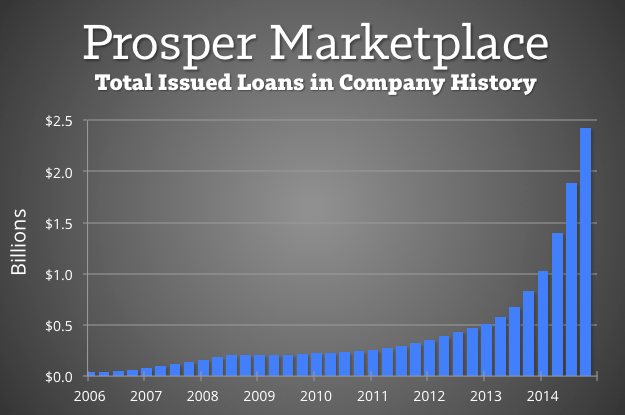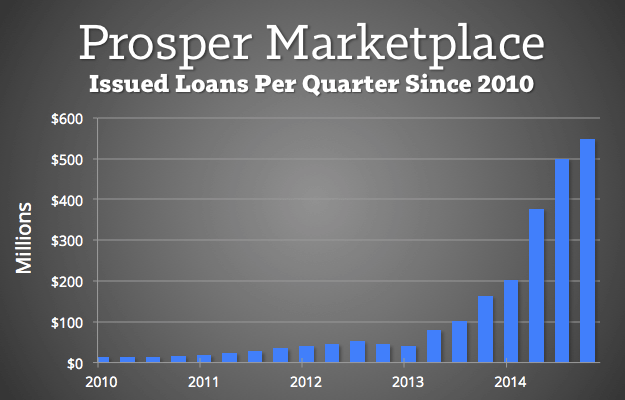This month I had the opportunity to sit down with Aaron Vermut, CEO of Prosper, and talk about the success that his company has experienced in the past twelve months. This is becoming a regular theme in Prosper’s story considering the last interview was also growth-focused — “Vermut Reflects on $1 Billion Issued Loans“. Indeed, a year later this remains their identity. Prosper continues to soar and demonstrate tremendous potential.
I was again struck by Aaron’s transparency and ability to dialog about weighty and complex issues. Walking away from Prosper’s headquarters, I left convinced that this company is both (1) solidly focused on borrower satisfaction and (2) it is being expertly managed. I went home feeling a great deal of trust and respect toward Prosper Marketplace, and remain excited about the future of this company.

Interview with Prosper Marketplace CEO
One of the most amazing things for me is how much Prosper has grown in the past year. Back in 2013, you issued “just” $369 million in loans.
Aaron Vermut: If you recall, in the middle of 2013 we rewrote the borrower funnel, put in FICO, and prices were dropped. In the 3rd quarter of 2013 we essentially relaunched the product, and by December $67 million in loans were being done on the platform. Originations were going up and losses were coming down. Things were working.
Then in 2014 a staggering $1.6 billion in new loans were originated through Prosper, growing by 350% in just twelve months, both in issued loans and revenue. This is incredible success. What would you say are the top three things that helped that happen?
First, improving our credit model. Second, the team here at Prosper Marketplace. Third, our partnerships.
PMI-5 generated a 40% boost in efficiency alone.
Our credit model released PMI-5 last year, its fifth version. This was the biggest factor by far. You can do everything you want in marketing and websites and speed, but nothing helps more than just identifying your customers better and giving them access to a bigger loan at a better price.
That makes sense. In many ways, Prosper as a company is just a giant credit model.
PMI-5 generated a 40% boost in efficiency alone, meaning the amount of loans we originated through our platform compared to what we spent on marketing. If you look at the growth from the second to the third quarter of 2014 there’s this huge ramp up, so that was a really big deal.
How has the team at Prosper changed in the past year?
We’ve gone from 80 people to 240 people in 12 months. In 2014 alone we hired a CFO, a CMO, and five VPs. And each of those VPs started building their own teams. We opened our verification center in Phoenix. In short, we fundamentally improved the talent. What really helps is our in-house recruiters, whose full-time job it is to find great people to work here.
Compared to a year ago, it is amazing how many more people are walking around this office.
We also diversified our marketing channels to include more partnerships and less direct mail. We have partners like CreditKarma, LendingTree, and BankRate who we work with to send us leads. These partnerships are cost effective and bring in significant business.
One of the most interesting things we found was the archeology aspect to fixing our technology. The servers had not been refreshed in many years, and there was nobody at the company anymore that had set them up originally. The team tasked with fixing them did an exceptional job, and the speed and performance increase of this fix alone increased our business by 5%.

Let’s talk about the secondary loan market, Foliofn. Would you consider Prosper notes to be a liquid investment, something investors can enter and exit with ease?
No. We tell investors they should not expect to be able to sell their notes on a secondary market. I actually think there is this great opportunity for somebody to come along and rebuild the secondary market. Lending Club and Prosper aren’t going to do this together, so somebody has to become a broker-dealer and become the aggregator. I recognize the experience could be a lot better.
It’s good to hear that you are aware of this issue.
Our investor team is working with Folio Investing to simplify and improve the secondary market experience. It is part of our larger goal to rebuild the entire investor experience. But our biggest “holy grail” is for investors to go into their E-Trade or Schwab account and to simply buy a ticker of Prosper notes.
That would be huge. When do you think Prosper will be a box that you can click in your Betterment account?
Those guys are RIAs. They are wealth advisors. When you create your portfolio, they go out and buy ETFs or Vanguard funds along your preferred asset classes, keeping the costs low and rebalancing every quarter. What we do not have right now is a public vehicle for them to include Prosper loans. There is no ETF for unsecured consumer credit, and there probably won’t be. An ETF needs to possess the liquidity to be bought and sold, which our loans do not have.
The way to do it is with a ’40 Act fund, like a closed-end mutual fund.
The way to do it is with a ’40 Act fund, like a closed-end mutual fund. Basically you would take a half a billion dollars worth of loans and put them in a closed-end fund that’s exchange traded, and people could buy that. Then the mutual fund dividends out the interest payments. So a ’40 Act fund would be something that you could invest in through your E-Trade or Schwab account, and we are working with potential asset managers who are interested in making this happen.
What’s so great about a site like Betterment is that they show returns of each asset class over time. And in a down market you would have most of them tanking while p2p loans remained strong. Thousands of people would suddenly discover consumer credit’s stability and great returns.
Absolutely. It’s a non-correlated return. But if you want to get that mass appeal, you have to create the opportunity for people to just say to their advisor, “Buy me some of this.” Managers like Betterment or Charles Schwab need a vehicle that allows them to keep custody of your invested cash. So that’s one of my goals for 2015.
Prosper’s new office is next door to Charles Schwab.
That’s true. Maybe they will be a future partner.
So will self-directed retail be superseded by these upcoming mass appeal ’40 Act funds?
Retail remains a priority for us. The company and the industry would not be here without those bleeding-edge hobbyist investors. Remember, when we got here in 2013 it was only retail. They are in the DNA of this company, what got us started, and we are committed to serving this group.
I don’t think it is a coincidence that the only two platforms that have achieved scale are the only ones for which the SEC has approved the retail offering. Why would we abandon that? We have a compliance process that helps us ensure we continue to comply with the securities and many other regulations that govern this business. The compliance is expensive, but it’s important, and we will continue to invest in this channel.
 Adam from WriteYourOwnReality just published an article comparing your fractional versus whole loan volume, and one could say it shows the retail experience staying the same since 2013.
Adam from WriteYourOwnReality just published an article comparing your fractional versus whole loan volume, and one could say it shows the retail experience staying the same since 2013.
One could say that pretty accurately.
So you would agree with the statement that retail investing at Prosper has not changed in two years?
Yes. Perhaps it has grown a bit. I think retail ranges from $10 to $15 million per month, up from $8 or $9 million since before Steve, Ron and I got here. Obviously we were more in a survival mode over the past two years just to make sure we could scale the business and make it work.
This is an issue I’m wrestling with. I love your company and the products you offer. Prosper is one of the only places in the nation where average people can invest in prime consumer credit. And you have stated that retail is a crucial part of your DNA, yet Prosper has done nothing about it for the past two years.
This is one of our goals for this year. Not only are we starting to invest in new tools, but we have resolved to spend money marketing to retail, and even buy ads on financial websites for investors to come and create accounts on our site. We want to be careful with it until we build out a better investor application, but the investment will give us the data to be better at it in the future. By the end of 2015, the retail investor experience for fractional notes will be totally different.
Let’s talk about the recent restrictions you made to your public loan data.
We recently made two big changes to our open data. First, we stopped releasing our monthly numbers and began to report quarterly. I want my team to have a longer time-horizon than 30 days.
I always thought the monthly numbers felt a bit frantic.
No company manages to a monthly number. The other thing we did was stop people from mapping each borrower’s credit data back to their loan.
There are companies out there with loan products that are basically reverse-engineered from our credit model.
Because we’ve been successful, there are companies out there with loan products that are basically reverse-engineered from our credit model. And they’re breaking the law. They are violating our Terms of Use. Some of them have even admitted knowingly reverse-engineering our credit model, so we’ve just taken away that temptation.
One of the things that makes peer-to-peer lending special is its open data.
Right. And the open data is fine, you just can’t reverse-engineer our credit model. We have millions of dollars of investment into that model and need to protect it.
I think investors like myself deeply value the open data’s protective element, its ability to validate the quality of your loans.
While I appreciate the protective aspect of it, what do you do against competitors who are actually stealing your data and using it for profit?
There is a tension there, releasing enough data that allows investors to validate your loan quality, but restricting it enough to stop competitors from stealing your credit model. I guess I’m wondering if the open data was something the platforms had to create trust and hit profitability, and now that you are successful, it will go away.
I do not think many of our investors would even buy loans if we did not give them enough data to verify it themselves.
So open data is a permanent fixture of your company?
For me it is. Again, it is part of our DNA. It is part of what keeps us honest.
Think back to early 2013 when your team had just finished the 100-days campaign. Talk about where you are today compared to back then.
If you had told any of us two years ago that we would be where we are today, we would have thought you were out of your mind. Frankly, it’s been a lot of hard work. 2013 was a particular challenge. But our success in 2014 showed us the hard work was worth it. And we are so proud of what we’ve done. It has been an incredible two years.

What would you consider is the most enjoyable part of your job?
Honestly, it’s really cool to be in a business where the employees feel good about what they are doing. I do a monthly town hall, and we recently showed some videos about how we’re helping people. This month we’re talking about elective medical, and about the guy who won our $2 Billion Strong contest in October. He used a loan to get a lap band procedure.
I saw the video. “Prosper saved my life.”
Pretty amazing, right?
Definitely. What does 2015 hold for Prosper?
We are working on a new brand and logo. We also have plans to expand our offline advertising, like television and radio. But the most sizable goals are a further refinement of our credit model, new tools for investors, and our continued focus on mobile.
Is Prosper ever going to release a mobile app, like Uber for loans, an app where I can just stand on a street corner, realize I need a quick infusion of cash, and click a big button to get a loan?
The Prosper app is slated for 2015. We have iOS and Android engineers actually working on it right now. The process is a bit more complicated than that. You still have to provide verification data and the like, but it should be even easier for people to get loans.
In closing, what excites you about where Prosper is heading?
For me, the most exciting thing is to be at the point of sale. That’s the end game. Look at our recent purchase (TechCrunch) of American HealthCare Lending. They have a software tool that sits in the doctor’s office and helps the doctor arrange for financing.
“You’ve been approved for a Prosper loan,” the doctor tells the patient.
Right. You can take that capability and translate it to other verticals such as home improvement, giving it to contractors and different kinds of merchants. Currently people come to us, but if we can be in front of the customer at the decision point, and people trust our brand, that’s the foundation for a company to achieve a billion dollars in revenue.

Great interview Simon, and thank you for the mention. The partnerships/investments in point of sale and originations that Prosper is focusing will be the path of future growth. Now that they’ve gotten the credit model and some of the back end processes upgraded, these should push new borrowers through nicely.
Lastly, as a retail investor, the added focus this year on those investors will be quite interesting, and something I’m looking forward to seeing. I will absolutely be following up on my analysis next year to see what has changed in the proportion of growth that retail investors have seen in comparison to the institutional side. One challenge to Aaron’s answer to the question of retail/institutional split is that the gross dollar amount is less important than the quantity of notes. As most retail investors invest in small fractions of a loan, the increase in average loan size, which is the primary driver the growth that Aaron alludes to in his answer, is much less important than having more notes available.
Thanks again for sharing your interview.
Thanks Adam. Great point. Like you, I’m interested to see what things look like in the coming year. These loans are such incredible investments, and I’m eager for both self-directed retail and’40 Act funds to help people begin lending.
This was a fantastic interview and gets me even more fired up for Prosper. I have been with them since about 2010, but have only recently started contributing new funds.
Cheers!
Wow. You’ve been with them far longer than I have, so it’s cool to hear you’re still a fan.
The Prosper platform is very good. I’ve done well. The investor service is grossly incompetent. I’ve been trying to change banking information for over a year and have not yet succeded. I give it a try every few months – recieving various directions on how to change it – all to no avail. Can’t wait for my ntoes to mature so I can be done with this product.